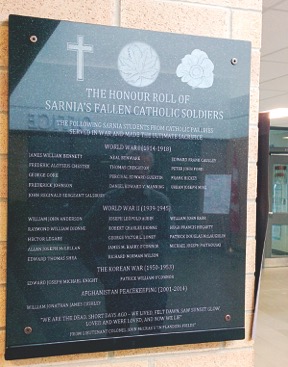Tom St. Amand and Lou Giancarlo, special to The Sarnia Journal
(2016) Sarnia war historian Tom Slater was visiting SCITS one day in 2012 when he noticed a memorial plaque displayed outside the main office.
Engraved on it were the names of former students who died serving Canada in the Second World War.
Slater, then a teacher at St. Patrick’s, hoped that one day his school would display a similar plaque honouring fallen Catholic students.
Today, such a plaque graces the lobby of St. Pat’s thanks to teacher Blake Morrison and principal Rob Cicchelli. Its official dedication is taking place this Remembrance Day.
The plaque offers the names of 30 fallen soldiers.
Some were blood relatives, like brothers James and Patrick O’Connor, and Raymond and Robert Dionne, father and son.
All, however, were ordinary men who did something extraordinary.
What united them forever was a passion to serve Canada. In a letter to Amelia Johnson, whose son, Frederic, had died at Vimy Ridge, a chaplain wrote, “How better can a man die defending his home, his country and his God?”
Most were bachelors; some, like James O’Connor, were married, and a few, Thomas Creighton, George Loney, and Mike Paithowski, for example, left behind young children. On leave, Petty Officer Paithowski bade farewell to his wife and infant son, the only time he would meet him. Within the year, the proud father was dead.
Like William Barr, Wilfred Knight, and John Salisbury, many enlisted right after high school, but a few joined much later in life. George Gore died in 1918 at the age of 38; Edward Shea, at 49.
Many had no military training. Rather, they left their jobs as labourers, salesmen, mechanics and clerks to serve. A few though had some military experience. Neal Benware had served with the 27th St. Clair Borderers and Percy Guertin, with the 97th Regiment. In fact, Percy’s great-grandfather fought in the War of 1812.
Will Cushley was so eager to serve that military recruiters asked that he stop contacting them about his application status. Raymond Dionne served in both world wars, Patrick O’Connor in the Second World War and the Korean War.
Robert E. Lee, no stranger to warfare, once said, “What a cruel thing war is.”
These men all died far too young.
Many perished on land, mostly in battles now famous in history: Frederic Chester at Somme; Richard Wilson during the Liberation of the Netherlands; Patrick McLaughlin at the Battle of the Rhineland; Joseph Aubin in the Italy campaign. Others died at sea, some on the same ship, and many in planes shot from the sky.
The funerals for Frank Hickey and Allan McLellan were held in Sarnia and both are buried in OLM Cemetery. In a cruel twist, both men died after the war ended, their deaths “due to Service.” Contrast that to Hector Legare who, in 1941, became the second Sarnian to die in the Second World War. Edward Causley is buried in France, but his uncle was thankful his nephew died painlessly “not knowing what hit him.”
European military cemeteries are the final resting place for James Bennett, Daniel Manning, and Urban Noel. Patrick O’Connor and Edward Knight are buried in South Korea.
Sadly other men, like Peter Ford, Bill Anderson, and Francis Hegarty, have no known grave, so their names are inscribed on the headstones of common graves or on war memorials.
These are the thirty men from Sarnia’s Catholic Community, all heroes, whose names are engraved on the plaque at St. Pat’s High School.
May they never be forgotten.


